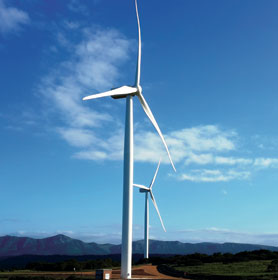

Situated in the Eastern Cape, one of South Africa’s first wind farms can produce up to 27 MW of power which is mostly utilised by the Nelson Mandela Bay Metro. When it came to finding a solution for controlling and managing the plant, Vijeo Citect from Schneider Electric was chosen as the preferred solution.
Meeting the system requirements
The system presented many challenges, among them the need to interface to third-party systems, and controllers from a variety of suppliers. But first of all, the system had to interface with the nine wind turbines and collect all critical system parameters for monitoring and historical logging. Furthermore, it had to interface with a local weather station to allow production forecasts based on the prevailing conditions.
Switchgear status and measurement data was to be collected from the main substation as well as the nine mini substations at each turbine. Apart from this the system also had to interface with the local municipality and with Eskom’s main control room via its RTUs. An international third party also connects remotely to the system to make use of the information for management and publication on the web.
Faced with all these challenges, Process Dynamics made the decision to use Vijeo Citect from Schneider Electric to simplify the integration task. The fact that a high volume of Schneider equipment was already installed at the farm supported the decision to use its products and solutions throughout the plant. A redundant ring network was configured using Schneider ConneXium switches on single mode fibre to connect all devices and turbines to the central control system. Since there is a possibility of the wind farm being isolated from the power network and thus left without power, all equipment was supplied with backup power using APC Smart UPS power also from Schneider Electric.
System architecture
The Citect Scada implementation is mainly used as a management tool and with the M340 PLC from Schneider also functions as the gateway between the different systems and users. Interfacing to the wind turbines was easily done using Modbus TCP and, as the local weather station also supported Modbus, it was easily integrated using an Ethernet/Modbus Gateway. The same method was used to integrate all the substation equipment that only supported Modbus serial.
With the wind farm spread over a large area and not being manned permanently, an SMS system was also implemented to warn personnel of alarm and weather conditions. Alarms can also be acknowledged via SMS and if no response is received within a predetermined time, the condition is escalated up the command chain. This ensures prompt response and reaction when an alarm or bad weather conditions exists.
The client required a reliable and expandable control system with maximum flexibility, but which could be easily maintained. Hence, the biggest challenge was to ensure that all systems could be integrated reliably and with the variety of systems involved, this was no easy task. Interfaces to Eskom and Nelson Mandela Bay Metropolitan also required date and time stamping with DNP3 protocol. The interfacing to the Moscad RTU’s was easily done using Schneider’s M340 DNP3 modules that support both serial and Ethernet communication with DNP3.
The biggest advantage of standardising on Schneider Electric equipment was that all the diagnostic information from network switches, gateways and I/O modules can be monitored and displayed to pinpoint any problems and ensure efficient problem solving. Choosing Vijeo Citect, and Schneider Electric as a partner for this project, was definitely the correct choice.
For more information contact Kobus van Niekerk, Process Dynamics, +27 (0)11 394 5412, [email protected], www.process-dynamics.co.za
| Tel: | +27 11 394 5412 |
| Email: | [email protected] |
| www: | www.process-dynamics.co.za |
| Articles: | More information and articles about Process Dynamics |
© Technews Publishing (Pty) Ltd | All Rights Reserved